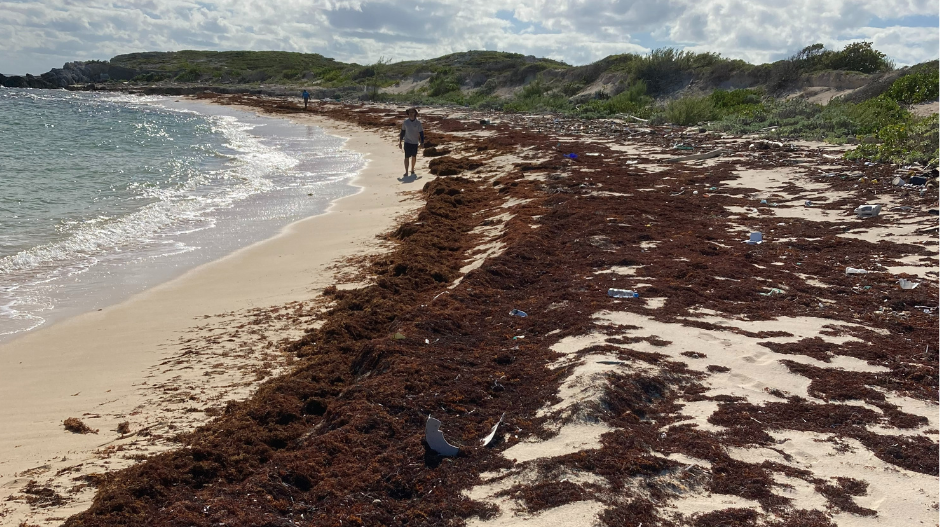Recently a Blue Belt Programme team travelled to the Turks & Caicos Islands to support the facilitation of a workshop on Sargassum influxes.
What is a Sargassum influx?
Sargassum is a brown seaweed of the order of Fucales. Sargassum is composed of various species, some of which have the unique characteristic of being are exclusively pelagic and as such they never attach to the seafloor. Sargassum has been long known to naturally inhabit certain areas of the Atlantic Ocean – the Sargasso Sea was notably named after this – however in recent years there have been sudden increases in Sargassum biomass which has led to higher influxes in coastal regions in the Caribbean and in West Africa. Causes for this sudden increase in Sargassum biomass are linked to increases in nitrogen and phosphorus in water. On beaches, large accumulations of Sargassum can significantly affect the daily life of local communities, as well as have economic impacts such as through reductions in tourism. It can also have detrimental effects on marine life by effecting water quality as it decomposes.

What did the workshop aim to achieve?
Titled 'Sargassum Mitigation Strategies and Adaptations in Turks and Caicos Islands', two workshops were held in Providenciales and in Grand Turk. The workshops were planned in close collaboration with the Department for Environment and Coastal Resources (DECR) of the Turks & Caicos Islands Government. The two sessions brought together and facilitated knowledge exchange and collaboration among experts, practitioners, policymakers, and local communities (on two islands) to devise effective strategies for managing sargassum influxes in the Turks and Caicos Islands.
The workshops aimed to foster dialogue and knowledge exchange among stakeholders with diverse experiences and expertise related to sargassum mitigation. Participants explored current Sargassum management practices across the Caribbean region, evaluating both successful strategies and existing challenges. The workshop delved into the potential benefits and opportunities associated with the valorisation and utilization of Sargassum in the context of the Turks and Caicos Islands. It sought to encourage cross-national and interdisciplinary collaboration to effectively mitigate the impact of sargassum influxes.

To support in achieving these objectives for the workshop, we invited four international experts to join us at the sessions:
- Dr Judith Rosellón-Druker from CONACYT (Consejo Nacional de Ciencia y Tecnología), Mexico
- Dr Janice Cumberbatch from CERMES (University of the West Indies), Barbados
- Yasa Belmar from CANARI (Caribbean Natural Resources Institute), St. Vincent and Grenadines
- Dr Thierry Tonon from the University of York, UK
Each of these speakers shared expert insights into Sargassum mitigation strategies, policy experiences, and innovative approaches from various regions. Participants then were able to engage in interactive activities focusing on challenges, opportunities, and participated in a real-time Sargassum vulnerability assessment exercise. These sessions facilitated group discussions and reflections, enabling participants to exchange views, questions, and insights on the workshop topics.
Marta Vannoni and Jon Hawes (Cefas) provided updates on Sargassum data specific to the Turks and Caicos Islands, including insights into local trends and patterns of heavy metals and other contaminants. This data provides us with a baseline for understanding risks and opportunities for Sargassum applications in the Turks & Caicos.

What’s next?
The workshop concluded with closing remarks highlighting key takeaways and outlining potential next steps in Sargassum management and adaptation efforts. It served as a brilliant platform for collaboration and knowledge-sharing, laying the foundation for informed decision-making and coordinated action in addressing the challenges posed by Sargassum influxes in the Turks and Caicos Islands. A workshop report is being produced by the Cefas team and this will form the basis for a Sargassum Management Plan to be shaped with Turks and Caicos Islands Government.
This workshop also marked a key milestone for Blue Belt in the work it is undertaking to support Caribbean Overseas Territories understand and address Sargassum influxes, and further emphasised the need for strong international collaborations to address issues and challenges that are transcending borders.
Leave a comment